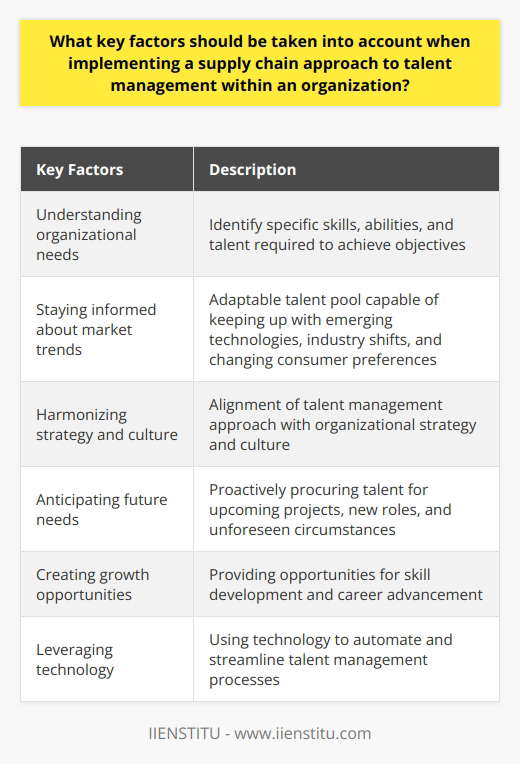
Talent strategy is essential for companies to ensure they have the right people in the right roles at the right time. Performance-based hiring is a process that helps companies identify the right talent and ensure they have the right people in the right roles. It evaluates the candidate's ability to perform the job rather than just their qualifications. When asked about the supply versus demand of talent, the usual answer is scarcity, as the demand for talent is usually more significant than the supply.
Companies need to understand their current and future hiring needs, assess the candidates' skills, knowledge, and experience, and understand the supply versus demand of talent to ensure they are hiring the right people for the right roles. Developing a talent strategy requires companies to understand their current and future hiring needs and adjust their strategy accordingly.
Introduction
What is Performance-based Hiring
What is the importance of getting the talent strategy figured out first
Supply vs. Demand
What is the usual answer to the question of supply vs. demand
Talent Strategy: Supply vs. Demand Drives Hiring Needs
Talent strategy is essential for companies to ensure they have the right people in the right roles at the right time. Performance-based hiring is a process that helps companies identify the right talent and ensure they have the right people in the right roles. Understanding the supply versus demand of talent is essential to ensure that the right talent is hired.
I. Introduction
A. What is Performance-based Hiring
Performance-based hiring is a process that helps companies identify the right talent and ensure they have the right people in the right roles. It is a system of hiring that focuses on the candidate's skills, knowledge, and experience instead of relying on traditional recruitment methods such as resumes or interviews. Performance-based hiring evaluates the candidate's ability to perform the job rather than just their qualifications. This process helps to ensure that the right person is hired for the job.
B. What is the importance of getting the talent strategy figured out first
Getting the talent strategy figured out first cannot be understated. Companies need to understand the supply versus demand of talent to ensure they are hiring the right people for the right roles. Companies need to understand their current and future hiring needs and be able to adjust their talent strategy accordingly.
II. Supply vs. Demand
A. What is the usual answer to the question of supply vs. demand
When asked about the supply versus demand of talent, the usual answer is scarcity. This is because the demand for talent is usually more significant than the supply. Companies need to understand their current and future hiring needs to ensure they have the right people in the right roles.
B. What is the simple strategy change that must be taken
The simple strategy change that needs to be taken is to focus on the candidate's skills, knowledge, and experience instead of relying on traditional recruitment methods such as resumes or interviews. Companies must evaluate the candidate's ability to perform the job rather than just their qualifications. This will help to ensure that the right person is hired for the job.
III. The Need for a Talent Strategy
A. Why is a talent strategy important
A talent strategy is essential because it helps companies to ensure they have the right people in the right roles at the right time. Companies need to understand the supply versus demand of talent to ensure they are hiring the right people for the right roles. They also need to understand their current and future hiring needs and be able to adjust their talent strategy accordingly.
B. How to develop a talent strategy
Developing a talent strategy requires companies to understand their current and future hiring needs. They need to assess the candidates' skills, knowledge, and experience to ensure they are hiring the right people for the right roles. Companies should also focus on the performance-based hiring process, which evaluates candidates' ability to perform the job rather than just their qualifications.
IV. The Benefits of a Talent Strategy
A. How does a talent strategy benefit the company
A talent strategy helps companies to ensure they have the right people in the right roles at the right time. This helps to ensure that the company can meet its goals and objectives. It also helps to reduce costs by ensuring that the right people are hired for the right roles.
B. How does a talent strategy benefit recruiters and hiring managers
A talent strategy helps recruiters and managers hire people for the right roles. This helps reduce the time and costs associated with recruitment and the risk of hiring the wrong person for the job. It also helps recruiters and hiring managers to focus on the candidate's skills, knowledge, and experience rather than relying on traditional recruitment methods.
V. Conclusion
A. Summary of the importance of a talent strategy
A talent strategy is essential for companies to ensure they have the right people in the right roles at the right time. Companies need to understand the supply versus demand of talent to ensure they are hiring the right people for the right roles. They also need to understand their current and future hiring needs and be able to adjust their talent strategy accordingly.
B. Summary of the benefits of a talent strategy
A talent strategy helps companies to ensure they have the right people in the right roles at the right time. This helps to ensure that the company can meet its goals and objectives. It also helps to reduce costs by ensuring that the right people are hired for the right roles. It also helps recruiters and hiring managers to focus on the candidate's skills, knowledge, and experience rather than relying on traditional recruitment methods.
In conclusion, a talent strategy is essential for companies to ensure they have the right people in the right roles at the right time. Companies need to assess the candidate's skills, knowledge, and experience to ensure they are hiring the right people for the right roles. They should also focus on the performance-based hiring process, which evaluates the candidate's ability to perform the job rather than just their qualifications. This will help to ensure that the right person is hired for the job and that the company can meet its goals and objectives.
Talent strategy is a balancing act of supply and demand, where the needs of the hiring process are ultimately determined by the market.
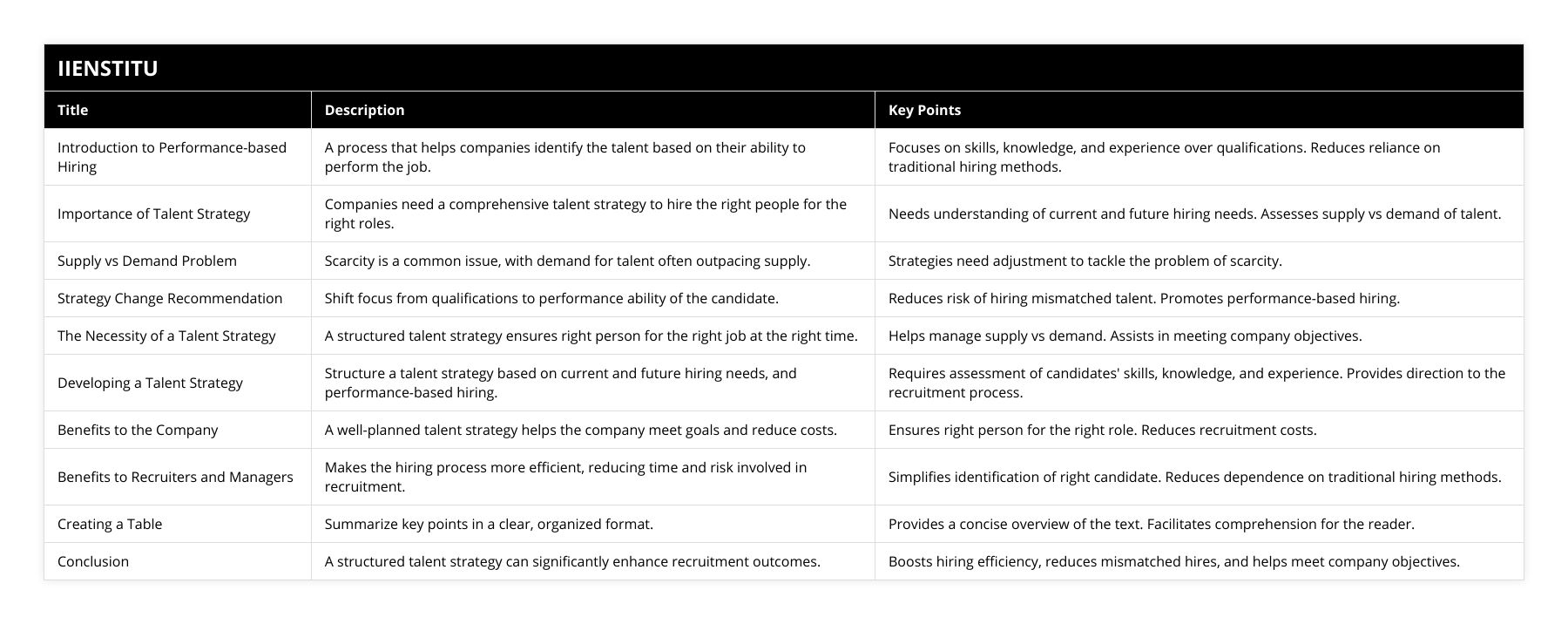
Frequently Asked Questions
What is the usual answer to the question of supply vs demand?
The supply versus demand question has been a long-standing issue in economics. The answer to this query is that supply and demand are interdependent. Supply is the amount of a good or service available in the market, and demand is the amount consumers are willing to buy at a specific price. Both supply and demand are determined by various factors such as price, availability, quality, and consumer preferences.
The usual answer to supply versus demand is that they influence each other. In other words, when supply increases, demand will decrease, and vice versa. This is because when the price of a good or service increases, the amount of people willing to purchase the good or service decreases, thus reducing the demand. Similarly, when the price of a good or service decreases, the number of people willing to purchase the good or service increases, thus increasing the demand.
In terms of equilibrium, the usual answer to the supply versus demand question is that the market is balanced when supply and demand are equal. In other words, the equilibrium price is the price at which the quantity supplied is similar to the amount demanded. This is an essential concept in economics as it helps explain why market prices are usually stable.
In conclusion, the usual answer to the question of supply versus demand is that supply and demand are interdependent and that when supply and demand are equal, the market is in equilibrium. Therefore, understanding the relationship between supply and demand is essential for economic analysis and is critical to understanding how markets function.
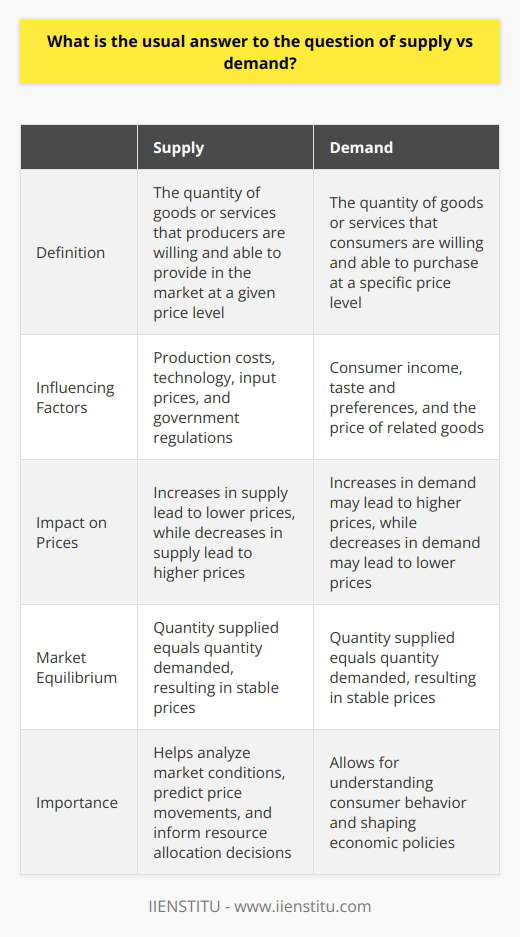
Why is a talent strategy important?
A well-defined talent strategy is essential to any successful organization in today's competitive global market. Talent strategies are designed to provide organizations with the ability to build, develop, and retain a pool of talented and motivated employees to ensure that the business can grow and succeed. In addition, a talent strategy provides organizations with a clear framework for aligning the company's needs with the employees' skills.
Organizations with an effective talent strategy understand the importance of investing in developing their employees to gain a competitive edge. A talent strategy enables organizations to shape the future of their workforce by investing in the skills, knowledge, and abilities of current and prospective employees. This allows organizations to identify and develop the most suitable individuals for the roles they are required to fill and create a culture of learning and growth.
In addition, having a well-defined talent strategy helps organizations attract and retain high-performing individuals. By investing in their employees, organizations can create an attractive and motivating workplace atmosphere for potential new hires. Furthermore, organizations with a talent strategy are better able to identify and address any gaps in their current workforce and develop strategies to fill those gaps.
Finally, having a talent strategy also helps organizations remain competitive in the market. By having a clear understanding of the skills required to succeed in their industry, organizations can better identify and develop the talent they need to remain competitive. In addition, this allows organizations to stay agile and adaptable to market changes and capitalize on new opportunities.
In conclusion, having a talent strategy is essential for any organization that wants to be successful in today's competitive global market. A talent strategy enables organizations to invest in their employees, attract and retain high-performing individuals, and stay competitive in the market. In addition, by having a well-defined talent strategy in place, organizations can ensure they have the resources and personnel they need to remain successful in the long term.
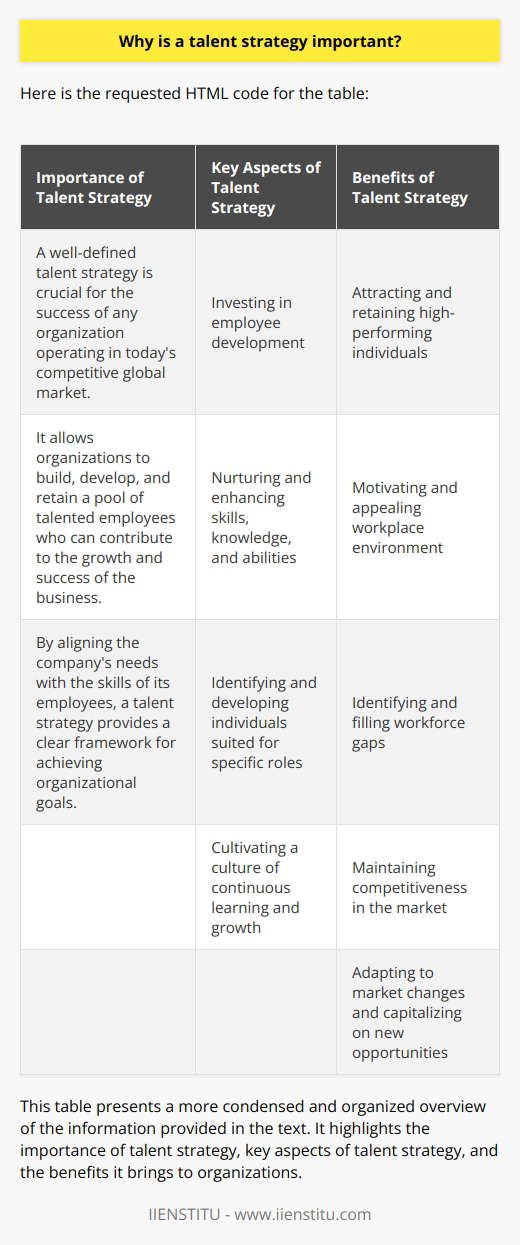
How does a talent strategy benefit recruiters and hiring managers?
Talent strategies are becoming increasingly important for recruiters and hiring managers in today's competitive job market. Talent strategies provide recruiters and hiring managers with the tools and processes to effectively identify, assess, and acquire talent. This article will discuss the benefits that recruiters and hiring managers can gain from implementing a talent strategy.
One of the main benefits of a talent strategy is improved candidate evaluation. With a talent strategy in place, recruiters and hiring managers have access to detailed candidate profiles and performance data to assess the skills and abilities of potential hires. This data-driven approach to recruitment ensures that recruiters and hiring managers can make informed decisions about which candidates to pursue and which to pass on. This helps to ensure that the recruitment process is efficient and effective.
Another benefit of a talent strategy is increased efficiency in the recruitment process. By implementing a talent strategy, recruiters and hiring managers can streamline their recruitment efforts. A talent strategy enables recruiters and hiring managers to quickly identify, assess, and acquire top talent, reducing the time it takes to fill an open position. This increases efficiency and reduces the cost associated with recruitment.
Additionally, recruiters and hiring managers can benefit from having access to a larger talent pool. A talent strategy provides recruiters and hiring managers access to a more comprehensive range of talent, including passive job seekers who may not be actively seeking employment. This increases the chances of finding the right candidate for the job.
Finally, a talent strategy can help recruiters and hiring managers better decide which candidates to pursue. By utilizing a data-driven approach to recruitment, recruiters and hiring managers can make informed decisions about which candidates to follow and which to pass on. This helps ensure that recruiters and hiring managers make the most of their recruitment efforts.
In conclusion, a talent strategy can provide recruiters and hiring managers with several benefits, including improved candidate evaluation, increased efficiency in the recruitment process, access to a larger talent pool, and better decision-making about which candidates to pursue. These benefits can help recruiters and hiring managers make better decisions about which candidates to follow and which to pass on, ultimately resulting in a more successful recruitment process.

What is the Supply Chain approach to talent management?
Supply Chain Approach to Talent Management
Understanding the Concept
The supply chain approach to talent management involves considering human resource management from a broader perspective, similar to supply chain management in the procurement of goods and services. In this context, talent management encompasses the entire process of acquiring, developing, and retaining the human capital needed to maintain a competitive advantage in the marketplace.
Acquisition Strategies
Effective talent acquisition begins with proper workforce planning and identification of the organization's talent requirements. The supply chain approach emphasizes the establishment of strategic partnerships with various sources of talent, including educational institutions, professional networks, and social media platforms. Organizations can enhance talent acquisition by using advanced data analytics, predictive tools, and innovative recruitment strategies that target the right candidates and optimize the application process.
Development and Retention Initiatives
In addition to acquisition strategies, the supply chain approach considers talent development and retention initiatives as interrelated components of talent management. Employee development programs aim to enhance the skills and capabilities of the existing workforce, ensuring that they remain competent and engaged in their roles. Some of these initiatives may include training, mentoring, and leadership development programs.
Retention strategies are aimed at maintaining employee satisfaction, engagement, and commitment, thereby reducing turnover and the associated costs. This can be achieved through various efforts, such as offering competitive compensation and benefits packages, fostering a positive work culture, and providing opportunities for growth and career advancement.
Continuous Improvement and Flexibility
A distinctive feature of the supply chain approach to talent management is the focus on continuous improvement and flexibility. This entails regularly reviewing and updating talent acquisition, development, and retention strategies based on real-time data and changing market conditions. Organizations need to be agile in adapting their talent management practices to the rapidly evolving demands of the global economy.
In conclusion, the supply chain approach to talent management represents a holistic, strategic, and data-driven perspective on human resource management. By adopting this approach, organizations can optimize their talent management practices, ensuring a strong and sustainable pool of human capital necessary for success in today's competitive market landscape.
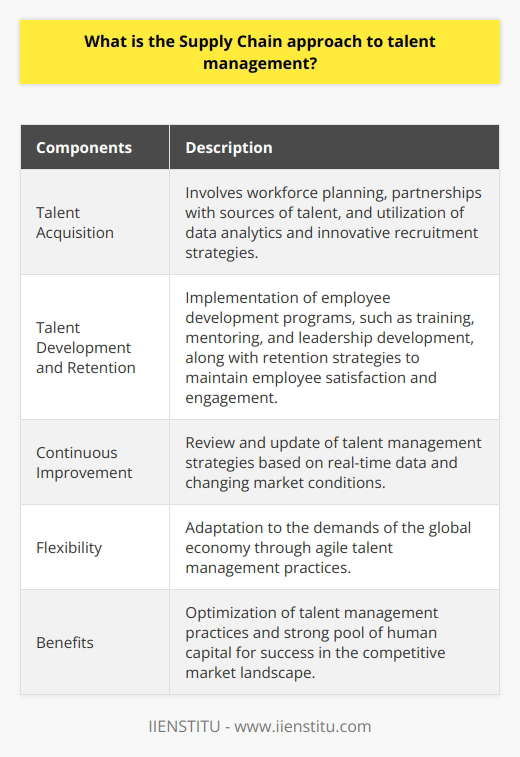
What are the seven components of talent management?
Understanding the Components of Talent Management
The concept of talent management encompasses a range of practices aimed at attracting, developing, and retaining skilled employees. Seven key components of talent management include:
Workforce Planning and Strategy
Workforce planning focuses on identifying and analyzing an organization's workforce needs to align with business objectives. Organizations should establish benchmarks for workforce quality, cost, and productivity in order to ensure operational efficiency and a sustainable talent pipeline.
Talent Acquisition
Talent acquisition refers to the process of identifying, attracting, and selecting candidates with the necessary skills and potential to support the organization's goals. Implementing effective recruitment strategies, such as utilizing employer branding and leveraging talent analytics data, can help an organization maintain a competitive edge in the job market.
Onboarding and Orientation
Successful onboarding and orientation programs help new hires acclimate to the organizational culture, build relationships, and understand job expectations. A well-structured onboarding process enhances employee engagement, productivity, and retention, contributing to a more cohesive workforce.
Learning and Development
Learning and development initiatives facilitate continuous skill and knowledge development within the organization. By offering targeted training, mentoring, and coaching programs, organizations can reinforce employee growth and address skill gaps effectively, fostering a culture of ongoing improvement.
Performance Management
Performance management involves continuously monitoring, measuring, and providing feedback on employee performance. By setting clear performance expectations, providing regular feedback, and recognizing employees' achievements, organizations can maintain a high level of employee engagement and motivation.
Career Planning and Succession
A holistic talent management approach should include provisions for career planning and succession planning. By offering clear career paths and facilitating internal mobility, organizations enable employees to take ownership of their career development. Additionally, robust succession planning ensures that the organization has a pipeline of talent ready to step in and assume leadership roles when required.
Employee Retention Strategies
Effective employee retention strategies aim to minimize turnover by addressing the factors that lead individuals to seek opportunities elsewhere. These strategies often focus on providing competitive compensation and benefits packages, fostering a positive work environment, and offering advancement opportunities.
By incorporating these seven components into an integrated talent management strategy, organizations can not only attract and develop skilled workers, but also retain valuable talent, thereby driving success and fuelling organizational growth.
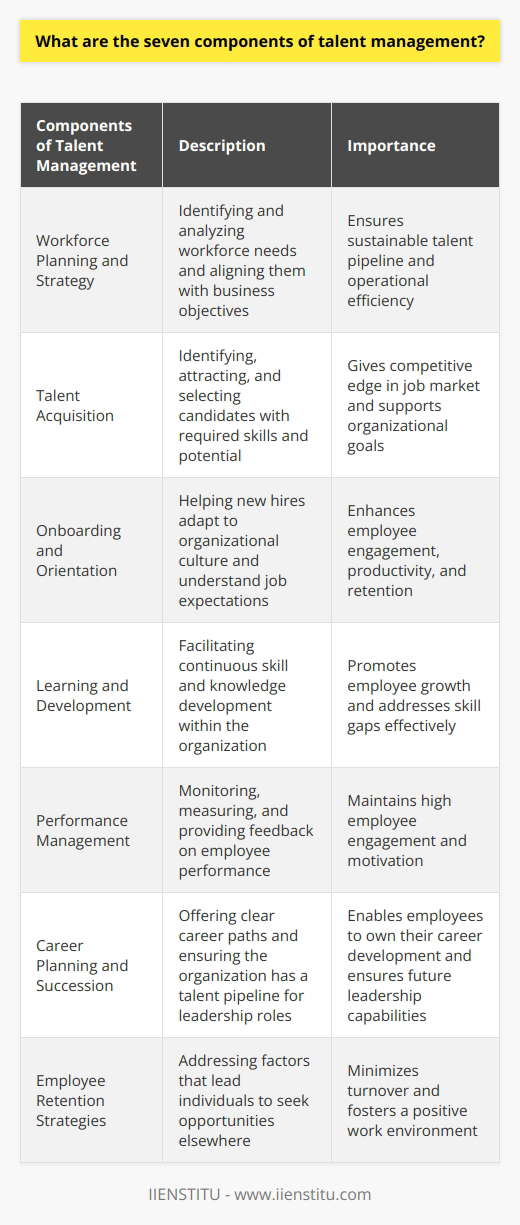
What are the four pillars of talent management?
**Defining the Four Pillars**
Talent management is a strategic approach to acquiring, developing, retaining, and utilizing human capital. The four pillars of talent management are talent acquisition, talent development, talent retention, and talent utilization. These pillars work together to create a comprehensive talent management strategy that optimizes the value of the organization's human resources.
**Talent Acquisition**
Talent acquisition encompasses the process of identifying, sourcing, and attracting the right individuals to fill vacant positions. This is a critical element of an organization's success, as the quality of employees directly impacts the organization's ability to innovate and adapt to market changes. Effective talent acquisition strategies involve understanding the organization's vision and culture, clearly defining job roles and competencies, and using data-driven methods to select the best candidates.
**Talent Development**
Talent development refers to the organization's efforts in providing employees with opportunities to advance their knowledge, skills, and capabilities. This consists of offering targeted training programs, coaching, and mentoring, as well as facilitating cross-functional learning experiences. By investing in employee development, organizations can enhance their overall performance, improve employee engagement, and ensure their workforce can continue tackling the dynamic business environment.
**Talent Retention**
Talent retention involves creating a positive work environment that encourages employees to remain with the organization for a longer period. This can be achieved by offering competitive compensation packages, providing meaningful career paths, and establishing a culture of recognition and reward. Organizations with high talent retention rates benefit from reduced employee turnover costs, stronger institutional knowledge, and greater employee loyalty, which all contribute to increased long-term success.
**Talent Utilization**
Talent utilization involves effectively deploying the acquired and developed talents to optimize organizational performance. This includes determining the optimal employee roles based on their skills, experiences, and competencies, and ensuring that the workforce is properly aligned with the organization's strategic objectives. Organizations that effectively utilize their talent pool benefit from increased efficiency, task specialization, and stronger team dynamics, ultimately driving more value from their human capital investments.
In conclusion, the four pillars of talent management – talent acquisition, talent development, talent retention, and talent utilization – are crucial components in crafting a holistic strategy for harnessing and optimizing human capital. By focusing on these essential elements, organizations can maximize the effectiveness of their talent management efforts, driving long-term success and competitive advantage in the knowledge-based economy.
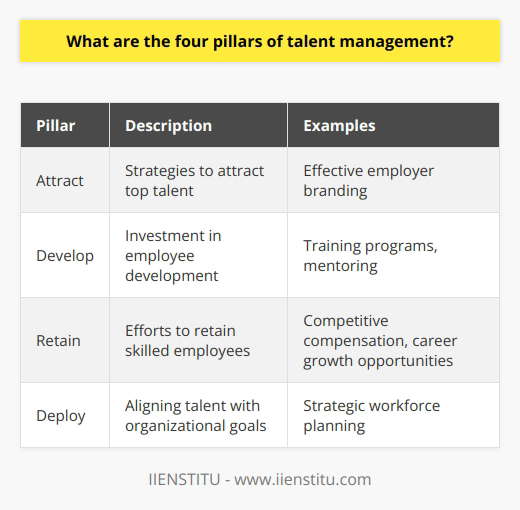
How do you determine hiring needs?
Assessing Current Workforce
To determine hiring needs, organizations must first assess their current workforce. This involves analyzing the number and types of employees available, their skills and experience, and the workload they can effectively handle. Understanding the current situation is crucial to identifying gaps in personnel and determining the areas where new hires are required.
Identifying Business Goals
Next, organizations should establish clear business goals and objectives. These should be linked to the organization's overall strategic plan, as they will guide the decision-making process with respect to staffing needs. Goals and objectives provide a roadmap to the future and help leaders understand where the organization is headed, allowing for more informed decisions in regard to hiring.
Forecasting Future Talent Requirements
Once business goals are established, it is essential to forecast future talent requirements. This involves predicting which skills and roles will be needed to support the organization's objectives, taking into account factors such as future growth, technological advancements, and industry trends. Talent forecasting helps organizations identify the types of employees they will need to succeed in the future and allows them to plan ahead for recruitment and skill development efforts.
Analyzing Turnover and Employee Retention
Another important aspect of determining hiring needs is analyzing employee turnover and retention rates. High turnover rates may indicate a need for stronger recruitment efforts, better onboarding processes, or increased focus on employee satisfaction and engagement. Understanding the factors contributing to turnover helps organizations create effective strategies for attracting and retaining talent, ultimately resulting in a more efficient hiring process.
Creating a Talent Acquisition Strategy
Finally, organizations must devise a comprehensive talent acquisition strategy that considers all the above factors. This strategy should include setting hiring goals, outlining desired qualifications and characteristics for new hires, creating recruitment and onboarding procedures, and establishing methods for measuring hiring success. Having a well-defined talent acquisition strategy guides organizations in their hiring process, ensuring that they hire the right people to fill identified gaps and drive overall business success.
In conclusion, determining hiring needs requires organizations to assess their current workforce, identify clear business goals, forecast future talent requirements, analyze employee turnover and retention, and create a strategic talent acquisition plan. Taking these steps will help organizations make informed decisions, ensure the right people are in the right roles, and ultimately support their future growth and success.
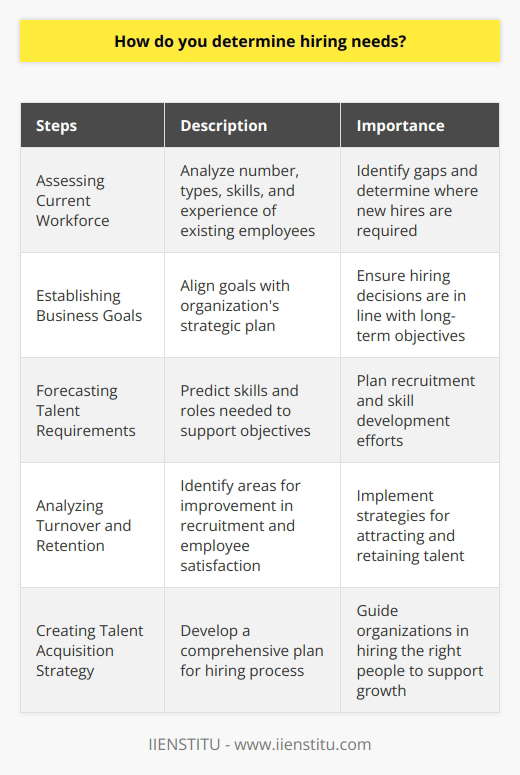
What role does a talent management strategy play in organizational success?
Talent Management Strategy's Role
A talent management strategy plays a crucial role in organizational success, focusing on attracting, developing, and retaining skilled employees. This comprehensive approach supports the organization's goals, maximizes productivity, and sustains competitive advantage.
Attracting Skilled Employees
One critical aspect of a talent management strategy is recruitment. By identifying the right talent with requisite skills, the organization secures a steady talent pipeline, ensuring its long-term growth and success. Implementing efficient selection techniques, such as competency-based assessments, improves the quality of the recruited workforce.
Developing Employee Skills
Talent development is another vital component of the talent management strategy, contributing significantly to organizational success. Through targeted training and development programs, organizations can upskill their employees, closing any skills gaps. By doing so, improved employee performance and job satisfaction are achieved, leading to increased overall productivity.
Supporting Organizational Goals
Talent management strategies should be aligned with the organization's objectives, ensuring the workforce is prepared to achieve these goals. This critical alignment facilitates more efficient management and enables employees to understand their roles in realizing the organization's vision. Communication of clear expectations and objectives also helps to increase employee engagement, which further drives success.
Retaining Top Talent
Retention is a critical challenge in talent management, as organizations must continuously work to keep their skilled employees. By acknowledging their contributions and offering career development opportunities, organizations can boost employee satisfaction, making them less likely to seek alternative employment. A well-executed talent management strategy should leverage employee retention to maximize organizational effectiveness.
Sustaining Competitive Advantage
In conclusion, a successful talent management strategy plays a pivotal role in sustaining an organization's competitive advantage. By attracting skilled employees, developing their skills, aligning objectives, and retaining top talent, organizations can build a strong workforce that consistently meets goals, driving the indisputable success of the organization.
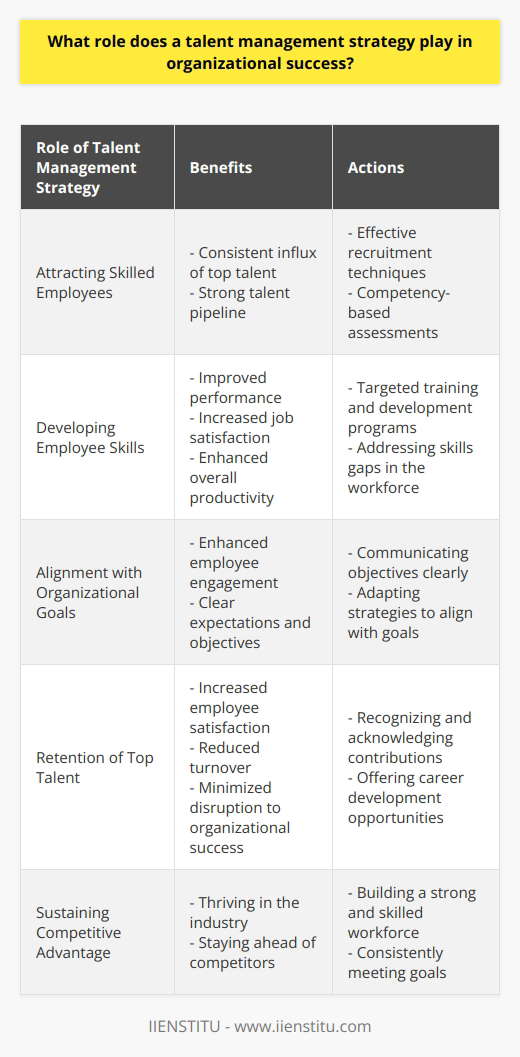
How can a comprehensive talent management approach improve employee retention and engagement?
Comprehensive Talent Management for Employee Retention and Engagement
Understanding Employee Needs
A comprehensive talent management approach inherently considers an individual's personal and professional needs, ensuring employees feel valued and satisfied in their roles. By placing emphasis on transparent communication and collaboration, organizations can better understand employee goals, aspirations, and challenges. This understanding leads to the implementation of tailored strategies that address these needs, fostering a sense of inclusion and loyalty among staff.
Personalized Development Opportunities
To further improve employee retention and engagement, a comprehensive talent management approach must incorporate personalized development opportunities. By investing in skill development, training, and mentorship programs, organizations demonstrate their commitment to employee growth and advancement. This investment not only elevates the employees' competencies, but also their sense of self-worth and motivation, as they recognize their importance to the organization.
Flexible Work Environment
Introducing flexibility and adaptability in the work environment is an essential component of a comprehensive talent management approach. Employees are more likely to remain engaged and retained when organizations demonstrate openness to remote working, flexible schedules, and an adaptive management style. This flexibility acknowledges employees' personal lives, which in turn fosters a strong work-life balance and holistic well-being.
Employee Recognition and Incentives
Lastly, maintaining employee retention and engagement requires a system of recognition and incentives within a comprehensive talent management approach. By acknowledging employees' hard work and achievements through rewards, incentives, and positive feedback, organizations cultivate a culture of appreciation and motivation. This positive reinforcement not only boosts morale but also encourages employees to strive for advancement and growth.
In conclusion, a comprehensive talent management approach holds the potential to significantly improve employee retention and engagement. By prioritizing employees' needs and development, providing flexible work environments, and consistently recognizing achievements, organizations can foster a supportive and rewarding culture, ensuring long-term satisfaction and commitment among employees.

What are the talent management strategies?
Talent Management Strategies
Understanding Goals and Objectives
Effective talent management strategies begin with a clear understanding of an organization's goals and objectives. This helps to determine the required skills and competencies necessary for success. By identifying these key attributes, organizations can then create targeted recruitment and selection processes to acquire the most suitable candidates.
Personalized Learning and Development
Providing personalized learning and development opportunities is crucial in nurturing the potential of each employee. This may involve creating individual development plans, offering mentorship programs, providing workshops and seminars, and creating a supportive learning environment. These initiatives not only improve employees' skills and knowledge, but also enhance their engagement and job satisfaction.
Employee Retention Efforts
To retain top talent, organizations must develop strategies that address employees' needs and expectations. This includes offering competitive compensation and benefits packages, promoting work-life balance, providing opportunities for advancement, and maintaining open lines of communication. By addressing these factors, organizations can boost employee satisfaction and reduce turnover rates.
Succession Planning and Leadership Development
Succession planning is another fundamental talent management strategy that ensures the smooth transition of leadership within an organization. Identifying and developing potential leaders helps to maintain continuity and prepare for future challenges. Leadership development programs, such as targeted training and mentorship opportunities, should be implemented to groom high-potential employees for these roles.
Performance Evaluation and Feedback
Regular performance evaluations are essential in monitoring employees' progress and development. By implementing a structured and objective appraisal system, employees can receive valuable feedback on their performance, which helps to identify areas for improvement and recognize their achievements. This transparent process also helps to establish a culture of continuous learning and improvement within an organization.
In conclusion, a comprehensive and effective talent management strategy encompasses various key aspects, including understanding organizational goals and objectives, personalized learning and development, employee retention, succession planning and leadership development, and performance evaluation and feedback. By implementing these strategies, organizations can maximize the potential of their workforce, ensuring continued success and competitiveness in the market.

How does the supply chain approach in talent management contribute to workforce planning and development?
Supply Chain Approach in Talent Management
The supply chain approach in talent management plays a crucial role in workforce planning and development by effectively addressing the talent acquisition, development, and retention processes. This approach involves proactively analyzing the demands of the labor market, identifying potential skills gaps, and devising strategies to close these gaps through targeted recruitment, training, and continuous improvement efforts.
Proactive Talent Acquisition
A vital component of the supply chain approach in talent management is proactive talent acquisition. This involves monitoring labor market conditions and identifying the skills needed to fulfill the organization's strategic objectives. By incorporating this information into a talent acquisition plan, organizations can strategically source and recruit high-potential candidates who possess the necessary skills to drive growth and success.
Targeted Skills Development
The supply chain approach in talent management also emphasizes targeted skills development. This entails identifying critical skills that are currently in demand and those projected to be needed in the future. By providing targeted training and development programs to address these needs, organizations can ensure their workforce remains competitive and continually adapts to evolving market conditions.
Performance Management and Retention
An effective supply chain approach in talent management also necessitates robust performance management practices. Organizations must continually assess employee performance against established objectives, providing constructive feedback and support to facilitate growth and improvement. Simultaneously, talent management strategies must focus on employee retention, particularly among high-performing individuals, through competitive compensation and benefits packages as well as meaningful development opportunities.
Continuous Improvement Efforts
Finally, the supply chain approach in talent management requires organizations to engage in continuous improvement efforts. This encompasses regular evaluation of talent management processes, benchmarks against industry best practices, and ongoing efforts to refine and optimize policies and procedures. By adopting this mindset, organizations can ensure they remain agile and responsive to the ever-evolving demands of the labor market.
In conclusion, the supply chain approach in talent management contributes to effective workforce planning and development by addressing critical areas such as proactive talent acquisition, targeted skills development, performance management, and retention. By incorporating this approach into talent management practices, organizations can better prepare for future labor market demands and maintain a competitive edge in today's increasingly globalized economy.

What factors should be considered when designing an effective talent management system?
Key Elements of Talent Management Systems
Effective talent management systems play a crucial role in fostering employee development and organizational success. When designing such systems, several aspects need to be considered to ensure their effectiveness and longevity.
Strategic Alignment
First and foremost, determining the strategic alignment of the organization allows human resources (HR) professionals to prioritize talent management initiatives that coincide with the organization's goals. By aligning efforts with the strategic plan, businesses can better utilize their resources, maximize productivity, and create a more engaged workforce.
Competency Frameworks
Incorporating comprehensive competency frameworks into talent management systems identifies the skills, knowledge, and abilities essential for each job role within the company. These frameworks serve as a foundation for employee development, recruitment, and performance management. By focusing on competency gaps, organizations can target specific areas to develop or recruit talent that will close these gaps and drive success.
Performance Appraisal
Designing an effective performance appraisal process promotes continuous improvement, strengthens employee-manager relationships, and identifies top performers for development initiatives. Regular performance feedback not only motivates employees but also offers critical information for identifying areas of improvement and promoting a culture of growth within the company.
Learning and development
Incorporating learning and development opportunities are vital for both employee knowledge and satisfaction. A robust talent management system should support personalized learning plans, offer diverse training opportunities, and invest in employee development. This fosters a culture of continuous improvement and adaptability among employees, thus impacting the overall success of the organization.
Succession Planning
Establishing a clear succession planning process for key positions cultivates a stable pipeline of potential future leaders. This forward-thinking approach ensures continuity in leadership positions, minimizes disruptions caused by turnover, and reduces the time and effort of external recruitment.
Employee Engagement
Lastly, employee engagement is the foundation of an effective talent management system. Prioritizing engagement by communication, recognition, and feedback strategies enables organizations to retain top talented individuals, reduce turnover rates, and increase overall performance.
In conclusion, an effective talent management system should address strategic alignment, competency frameworks, performance appraisal, learning and development, succession planning, and employee engagement. When these elements are thoughtfully considered and implemented, organizations can more effectively manage their talent and improve overall performance.
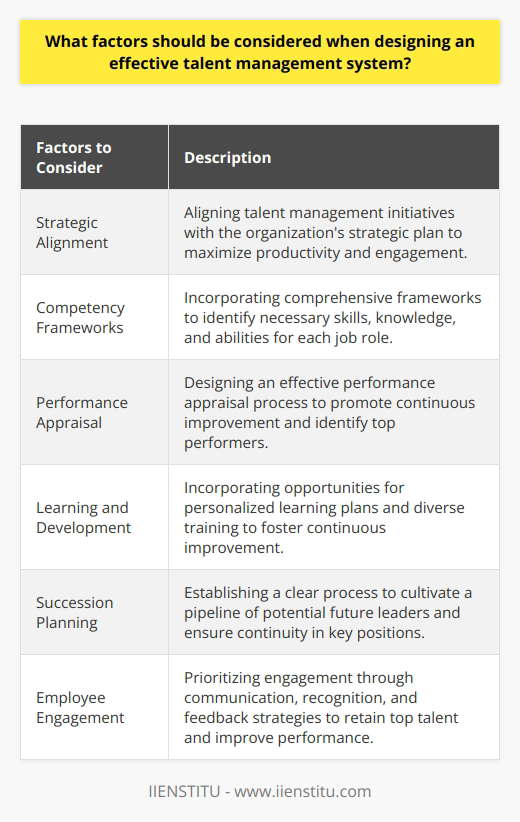
What is the concept of talent supply and demand in the context of workforce planning?
Understanding Talent Supply and Demand
Talent supply and demand refers to the balance between the availability of skilled workers and the needs of an organization. In workforce planning, understanding this concept is crucial.
Concept of Talent Supply
Talent supply refers to the available pool of candidates who possess the required skills and knowledge needed by an organization. This pool can range from current employees ready for promotion, to job seekers, to potential candidates in educational institutions or other organizations. Identifying the available talent supply allows companies to understand their potential recruitment sources and plan accordingly.
Concept of Talent Demand
On the other hand, talent demand refers to the workforce needs of the organization. This includes both the number of personnel and the specific skills and competencies required for the organization's current operations and future growth. A clear grasp of talent demand enables organizations to create precise recruitment strategies and training programs.
Talent Supply and Demand in Workforce Planning
Workforce planning involves analyzing talent supply and demand to ensure the right number of people with the right skills are in the right jobs at the right time. This approach ensures that the organization has a workforce capable of meeting strategic objectives.
Closing the Gap
A mismatch between talent supply and demand can lead to skills shortages or surplus, both undesirable to an organization. Skills shortages can harm productivity and competitiveness, while a surplus can result in inefficiency and wasted resources. Therefore, workforce planning aims to close this gap, aligning talent supply with organizational demand.
In conclusion, understanding talent supply and demand is vital in workforce planning. By balancing these two components, organizations can effectively manage their human resources, ensuring they have the required skills and competencies to achieve strategic goals.
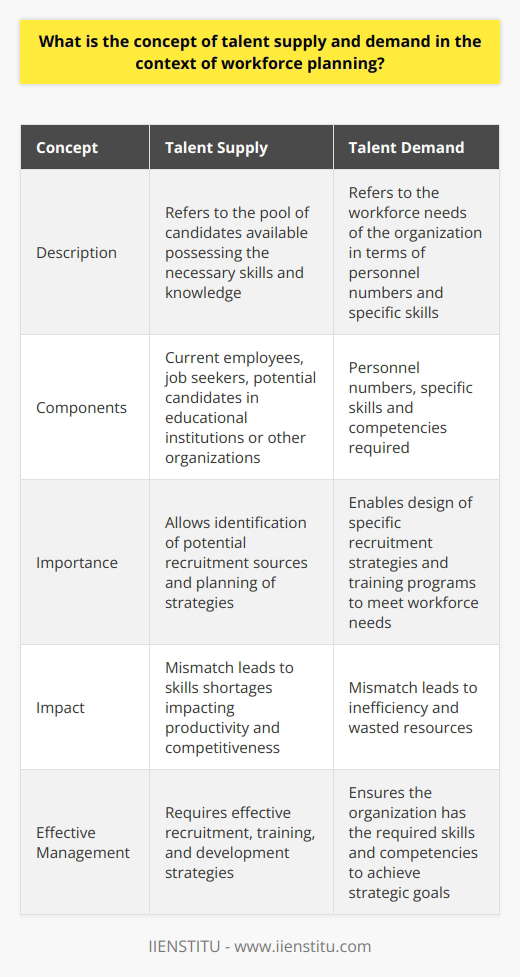
How does the integration of a talent supply chain strategy enhance an organization's performance and competitiveness?
Talent Supply Chain Strategy in Enhancing Organizational Performance
An organization integrating a talent supply chain strategy can notably enhance its performance and competitiveness. This approach promotes a comprehensive understanding of talent-resource utilization, facilitating effective recruitment, retention, and talent management.
Improved Recruitment Processes
By incorporating a talent supply chain strategy, the organization perceptively improves the recruitment process. Strategic recruitment can result in acquiring highly skilled personnel with the best fit to fill specific roles. Consequently, this leads to high productivity levels which consequently increases organizational performance.
Enhanced Retention Rates
Moreover, the strategy contributes to increased retention rates. By understanding the workforce's career aspirations and providing opportunities for growth, organizations establish a commitment-worthy environment that emboldens staff to stay. In turn, reducing staff turnover can lead to more stable operations, fostering higher performance degrees.
Streamlined Talent Management
Furthermore, this approach helps in streamlining talent management. The capacity to identify critical skill gaps in the workforce enables the organization to plan timely training and development programs. By doing so, the organization ensures that the workforce is well-equipped to meet the dynamic market demands. The resulting agility empowers the organization to stay competitive.
Additionally, the advantage of a talent supply chain strategy is the potential it introduces to align human resource strategies with the overall business strategy. When the workforce is strategically positioned to contribute to the business's goals, the direct impact on performance becomes tangible. Therefore, integrating a talent supply chain strategy is not just beneficial but vital for enhanced organization performance and competitiveness.
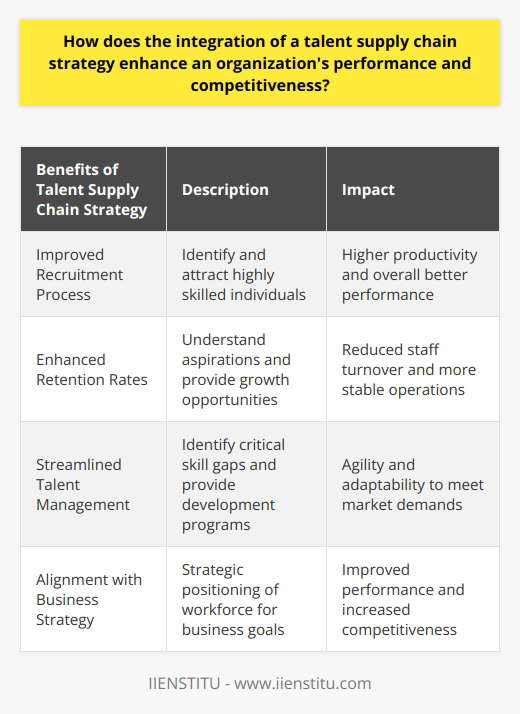
What are some best practices for implementing a talent management system within the context of the supply chain approach?
Defining the Talent Management System
A Talent Management System (TMS) is crucial to address a shortage of skilled workers within supply chain departments. It involves a systematic approach to identifying, developing, and retaining talent within the organization.
Understanding the Supply Chain Context
The supply chain context refers to the steps a product takes from its initial raw material stage to reaching the consumer. This procedure involves a diverse workforce, with different skills and talents, required at various stages.
Best Practices for TMS Implementation
Here are some best practices for implementing the TMS within the supply chain approach.
Clear Skill Mapping
First, conduct a comprehensive skill mapping. This process identifies the abilities of the workforce, highlighting the essential skills for each stage of the supply chain process. It aids in recognizing the skill gaps that need to be filled.
Regular Talent Evaluation
Second, continuous talent evaluation is necessary. Regular assessments allow the identification of high-performing employees, their career development needs, and employees requiring additional training.
Succession Planning
Third, establishing a succession plan improves the talent pipeline. This plan outlines the career progression opportunities for employees, reducing talent attrition, and ensuring talent availability in crucial roles.
Ongoing Staff Development
Finally, maintain ongoing staff development programs. Such initiatives ensure employees continue to upskill, meeting the evolving demands of the supply chain processes.
Overall, TMS implementation within the supply chain context involves clear mapping of skills, regular talent evaluations, succession planning, and continuous staff development. These practices ensure a suitably skilled workforce, resulting in more efficient and effective supply chain management.
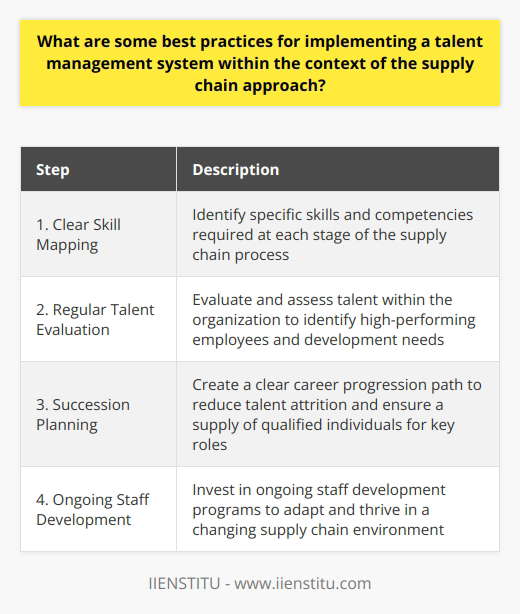
What is talent supply demand in the context of workforce planning?
Understanding Talent Supply Demand in Workforce Planning
Talent supply demand is a key factor in workforce planning. It refers to the process of monitoring and analyzing the availability and need for skills within a workforce.
Supply and Demand Basics
Talent supply involves considering factors like existing staff skills, potential employee development, and labor market trends. Organizations must understand their current talent, as well as potential sources for new talent.
On the other hand, talent demand is about having a clear understanding of the organization’s strategy and goals. Knowing the future needs of the company helps in identifying the type of talent required for success.
Balancing Supply and Demand
When addressing talent supply demand, organizations must create a balance. Too much supply can lead to overstaffing and increased costs. A lack of supply can result in skill gaps and hindered growth.
Role of Workforce Planning
Workforce planning plays a crucial role here. By systematically aligning talent supply with demand, it helps ensure the right people are in the right jobs at the right time. It involves forecasting future talent needs, informing recruitment and retention strategies, and planning for change.
Influence on Strategic Decisions
Understanding talent supply demand can shape an organization's strategic decision-making. It can inform areas such as recruitment strategies, training requirements, and succession planning. Such focus helps organizations remain competitive and agile in a volatile business environment.
In conclusion, effectively managing talent supply demand is key to successful workforce planning. It provides a robust framework for making informed, strategic hiring and development decisions that align with both current capabilities and future business needs.

How can the benefits of talent supply chain be leveraged to enhance organizational performance?
Enhancing Performance through Talent Supply Chain Management
Organizations can utilize talent supply chain management to garner several benefits that improve overall performance.
Elevation of Quality and Skillset
Standard supply chain practices aid in recognizing and securing high-quality talent. It helps identify a more precise match, streamlining the hiring process, and ensuring only competent professionals join the workforce.
Efficiency through Forecasting and Planning
Predictive analytics offers foresight into talent supply and demand. This feature allows organizations to pre-emptively strategize their talent sourcing, reducing turnover and improving employee retention, thus leading to organizational efficiency.
Scalability and Flexibility
Such management permits the fluctuation of staffing levels as per demand. It offers an agile workforce that can respond to varying market trends and business needs.
Risk Management
With a clear insight into talent supply and demand, organizations can manage risks associated with talent shortage or excess. This preparedness aids in mitigating potential performance issues.
Cost Reductions
Effective forecasting and planning limit the need for rushed or bungled hiring processes, reducing the associated costs. Furthermore, managing talent churn will help in limiting expenses related to onboarding, training, and turnover.
Accessibility to Broader Talent Pool
A talent supply chain offers access to a more extensive and diverse talent pool. This diversity instills a wide range of skills and perspectives into an organization, propelling innovation and ideation.
In conclusion, effectively leveraging the benefits of the talent supply chain can significantly enhance organizational performance. Through quality improvement, better planning, increased scalability, risk management, cost reductions, and exposure to a diverse talent pool, organizations can indeed find themselves bolstered in a competitive business landscape.

What key factors should be taken into account when implementing a supply chain approach to talent management within an organization?
Understanding Organizational Needs
The primary factor to consider when adopting a supply chain approach to talent management is understanding the needs of the organization. Every organization requires distinctive skills, abilities, and talent to achieve its objectives.
Assessing Market Trends
Market trends play a crucial role in talent management too. Responding to market changes requires an adaptable talent pool, willing to keep pace with emerging technologies, industry shifts, and consumer preferences.
Harmonizing Strategy and Culture
An organization's strategy and its overall culture should also be in alignment. Strategy often dictates the kind of talent needed, and the culture defines how this talent will thrive in the organization.
Anticipating Future Needs
You should also bear in mind the future needs of the organization. Anticipating new roles, upcoming projects or unforeseen circumstances can help procure talent proactively rather than reactively.
Developing Growth Opportunities
Providing opportunities for talent growth and skill development, is another factor that ensures that your talent supply chain remains robust. It attracts new talent and retains existing talent, thereby enhancing the organization's competitive edge.
Leveraging Technology
Finally, take into account the role of technology. Advances in technology can streamline talent management processes like recruitment, training and performance appraisals, making it easier to manage the talent supply chain.
Conclusion:
The aforementioned factors: understanding the organizational needs, responding to market trends, aligning strategy and culture, anticipating future needs, creating growth opportunities and leveraging technology, are key to successfully implementing a supply chain approach to talent management. When considered carefully, they create a talent management process that not only fulfills present needs but also prepares for future eventualities.
